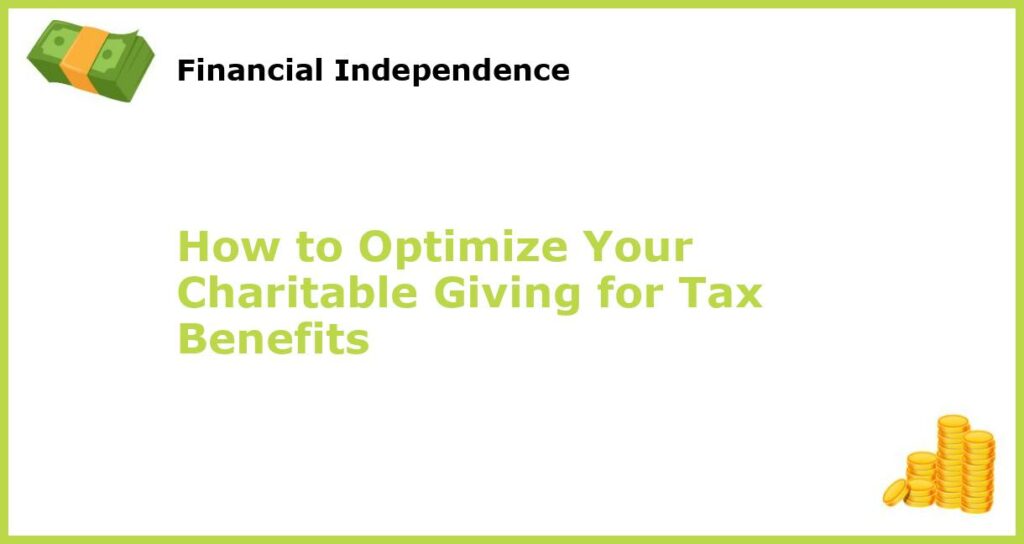Charitable giving not only helps those in need, but it can also provide tax benefits for the donor. However, many people may not be aware of the various strategies for optimizing their charitable giving for tax purposes. Here are ten tips to consider in order to maximize the tax benefits of charitable donations.
Take Advantage of Tax Laws

There are many ways in which charitable organizations can provide tax benefits to donors. One of the most advantageous methods is to donate appreciated securities instead of cash. This way, the donor can avoid paying capital gains tax on the securities while still receiving a charitable deduction for the full value of the securities. This often results in a larger deduction than if the donor were to sell the securities and donate the proceeds as cash.
Additionally, the CARES Act has made changes to tax laws in 2020, allowing for certain charitable contribution deductions to be limitless. For those who itemize their deductions, cash donations to a public charity can be deducted for up to 100% of the taxpayer’s adjusted gross income. Other charitable donations can still be deducted for up to 60% of the taxpayer’s adjusted gross income.
Give to Qualified Charities

It’s important to ensure that donations are made to qualified charities in order to receive tax benefits. This includes organizations recognized as tax-exempt by the IRS, such as religious organizations and charitable foundations. It’s also important to verify that the charity is legitimate to avoid any potential fraud or misuse of the donation.
Qualified charities can also provide documentation for tax purposes, such as a receipt or acknowledgement of the donation amount and date. This ensures that the donor has proper records for tax deductions and can avoid any issues with the IRS.
Bunch Your Donations

By bundling charitable donations into larger amounts, donors can maximize tax benefits. This means giving to charity less frequently but in larger amounts, resulting in a larger total deduction at tax time. For example, if a person normally donates $2,000 a year to charity, they could instead donate $4,000 every two years. By doing so, they would receive a single $4,000 deduction on their tax return for the year they make the donation.
This strategy is particularly beneficial for those who may not meet the amount required for itemizing deductions. However, with the recent changes to tax laws under the CARES Act, it might be more advantageous for some taxpayers to take the standard deduction instead of itemizing.
Utilize Donor-Advised Funds

Donor-advised funds are specialized accounts that allow donors to make contributions to charities over time while taking an immediate tax deduction. These funds can be invested and grow over time, and the donor can recommend how the funds are disbursed to charities over time as well. This allows for flexibility in charitable giving, as the donor can make contributions to the fund when it’s most advantageous for tax purposes and then choose when and how to distribute those funds to various charities.
However, it’s important to note that donor-advised funds are not the same as charities, and there may be fees or restrictions associated with them. Donors should be sure to research and understand the terms of the fund before utilizing them for charitable donations.
Consider Giving Real Estate

Giving to charity in the form of real estate can also provide significant tax benefits. If the real estate has appreciated in value, the donor can avoid capital gains tax and receive a charitable deduction for the full value of the property. This can be particularly advantageous for those looking to divest themselves of property that may be difficult to sell or those looking to downsize their real estate portfolio.
However, there are certain rules and requirements associated with donating real estate, such as getting proper appraisals and ensuring that the charity is able to accept real estate as a donation.
Donate Without Itemizing
Charitable donations can still provide tax benefits for individuals who don’t itemize their tax deductions. For those who choose to take the standard deduction, the CARES Act allows for an above-the-line deduction of up to $300 per taxpayer for cash donations made to qualified charities. This can be a great way for those who want to donate but don’t have enough deductions to itemize to still receive a tax benefit.
Be Strategic with Timing of Donations
By giving at the right time, donors can maximize tax benefits. For example, if a donor expects to be in a higher tax bracket next year, they can accelerate their charitable donations into the current year to take advantage of their lower tax rate. Similarly, donating appreciated securities before selling them can allow the donor to avoid capital gains taxes.
Timing can also be important in order to ensure that donations are made within a taxable year. For those who donate through check or credit card, it’s important to ensure that the donation is made and processed before the end of the year in order for it to be deductible on that year’s taxes.
Give Through Retirement Accounts
Donating through a retirement account, such as an IRA, can provide tax benefits for those over the age of 70 1/2. These donations are called qualified charitable distributions and can count towards the donor’s required minimum distributions while avoiding income tax on the donated amount. This can be a great strategy for those who may not need the full amount of their required minimum distributions and would otherwise have to pay taxes on that amount.
However, there are certain rules and limitations associated with qualified charitable distributions, such as a cap on the annual donation amount and the requirement that donations must be made directly to the charity from the retirement account.
Know the Rules for Non-Cash Donations
While donating non-cash items, such as clothing or household items, can still provide tax benefits, it’s important to understand the rules surrounding these donations. For example, the items must be in good condition and the donor must keep a record of the donation, including the fair market value of the items donated.
It’s also important to understand that the value of donated items is often not as high as the donor may expect, and there may be limitations on the amount that can be deducted. It’s important to consult with a tax professional or financial advisor before making non-cash charitable donations.
Get Professional Advice
Maximizing tax benefits through charitable giving can be complex, so it may be helpful to consult with a financial advisor or tax professional. They can provide guidance on the best strategies for individual situations and ensure compliance with tax laws. Additionally, it’s important to ensure that any charitable transactions are properly documented and reported on tax returns to avoid potential issues with the IRS.
By utilizing these strategies, donors can maximize the tax benefits of their charitable donations while still supporting causes that are important to them.







